Vaccine Education
A collaboration between the City of St. Louis Department of Health and the Saint Louis Science Center to increase awareness and understanding about vaccines in disease prevention.
Collaboration Overview
Vaccines protect an individual from many serious illnesses. They also have the potential to protect a community if enough individuals receive a vaccine and limit the places a virus can spread. To help the St. Louis community understand the importance and dispel misinformation of all vaccines, including the COVID-19 vaccine, the City of St. Louis Department of Health (DOH) and the Saint Louis Science Center have partnered to address vaccine hesitancy. The items below may be used to help share accurate information about vaccines with your family, friends, and the community.
More information about the collaboration with the Saint Louis Science Center program >>
Here's To Your Health
-
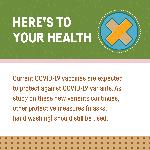 COVID-19 vaccines and variants Image
COVID-19 vaccines and variants Image
Current COVID-19 vaccines are expected to protect against COVID-19 variants. As study on these new variants continues, other protective measures (masks, hand washing) should still be used. -
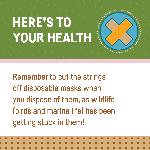 Disposable mask strings Image
Disposable mask strings Image
Remember to cut the strings off disposable masks when you dispose of them, as wildlife (birds and marine life) has been getting stuck in them! -
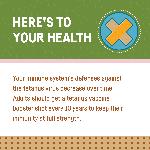 Longevity of a tetanus vaccine Image
Longevity of a tetanus vaccine Image
Your immunity system’s defense against the tetanus virus decrease over time. Adults should get a tetanus vaccine booster shot every 10 years to keep their immunity at full strength. -
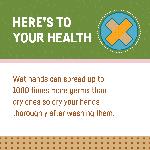 Wet hands and germs Image
Wet hands and germs Image
Wet hands can spread up to 1000 times more germs than dry ones so dry your hands thoroughly after washing them. -
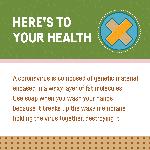 What is a coronavirus? Image
What is a coronavirus? Image
A coronavirus is composed of genetic material encased in a waxy layer of fat molecules. Use soap when you wash your hands because it breaks up the waxy membrane holding the virus together, destroying it!
Vaccine Vocab
-
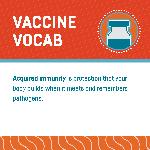 Acquired immunity Image
Acquired immunity Image
Acquired immunity is protection that your body builds when it meets and remembers pathogens. -
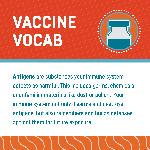 Antigens Image
Antigens Image
Antigens are substances your immune system detects as harmful. This includes germs, chemicals, or unfamiliar materials like dust or pollen. Your immune system not only disarms and destroys antigens, but also remembers and builds defenses against them. -
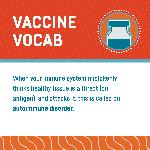 Autoimmune disorder Image
Autoimmune disorder Image
When your immune system mistakenly thinks healthy tissue is a threat (an antigen), and attacks it, this is called an autoimmune disorder. -
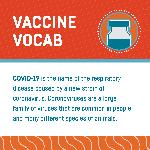 COVID-19 definition Image
COVID-19 definition Image
COVID-19 is the name of the respiratory disease caused by a new strain of coronavirus. Coronaviruses are a large family of viruses that are common in people and many different species of animals. -
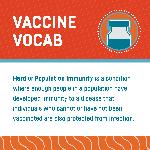 Herd of Population Immunity Image
Herd of Population Immunity Image
Herd of Population Immunity is a condition where enough people in a population have developed immunity to a disease that individuals who cannot or have not been vaccinated are also protected from infection. -
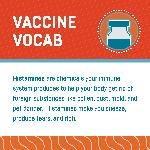 Histamines Image
Histamines Image
Histamines are chemicals your immune system produces to help your body get rid of foreign substances like pollen, dust, mold, and pet dander. Histamines make you sneeze, produce tears, and itch. -
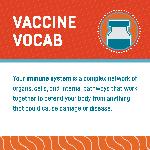 Immune system Image
Immune system Image
Your immune system is a complex network of organs, cells, and internal pathways that work together to defend your body from anything that could cause damage or disease. -
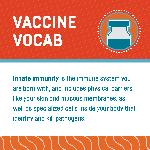 Innate immunity Image
Innate immunity Image
Innate immunity is the immune system you are born with, and includes physical barriers like your skin and mucous membranes, as well as specialized cells inside your body that identify and kill pathogens. -
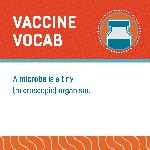 Microbes Image
Microbes Image
A microbe is a tiny (microscopic) organism. -
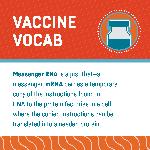 mRNA (Messenger RNA) Image
mRNA (Messenger RNA) Image
Messenger RNA is a just that - a messenger. mRNA carries a temporary copy of the instructions found in DNA to the protein factories in a cell where the copied instructions can be translated into a needed protein. -
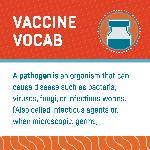 Pathogens Image
Pathogens Image
A pathogen is an organism that can cause disease such as bacteria, viruses, fungi, or infectious worms. (Also called infectious agents or, when microscopic, germs) -
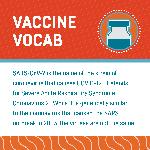 SARS-CoV-2 Image
SARS-CoV-2 Image
SARS-CoV-2 is the name of the strain of coronavirus that causes COVID-19. It stands for Severe Acute Respiratory Syndrome Coronavirus 2. While it is genetically similar to the coronavirus that caused the SARS outbreak in 2003, the viruses are not the same -
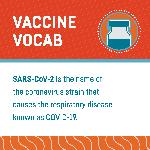 SARS-CoV-2 definition Image
SARS-CoV-2 definition Image
SARS-CoV-2 is the name of the coronavirus strain that causes the respiratory disease known as COVID-19.
Did You Know
-
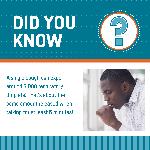 A single cough Image
A single cough Image
A single cough can expel around 3,000 respiratory droplets! That’s about the same amount released when talking for at least 5 minutes. -
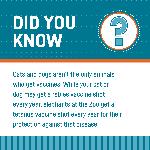 Animals and vaccines Image
Animals and vaccines Image
Cats and dogs aren’t the only animals who get vaccines. While your cat or dog may get a rabies vaccine shot every year, elephants at the Zoo get a tetanus vaccine shot every year for their protection against that disease. -
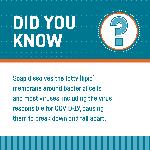 Benefits of soap Image
Benefits of soap Image
Soap dissolves the fatty (lipid) membrane around bacterial cells and most viruses, including the virus responsible for COVID-19, causing them to break down and fall apart. -
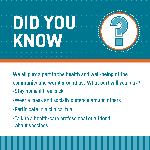 Community health and your part Image
Community health and your part Image
We all play a part in the health and well-being of the community and world around us. What part will you play? -
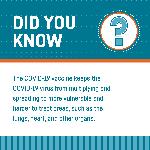 COVID-19 vaccine Image
COVID-19 vaccine Image
The COVID-19 vaccine keeps the COVID-19 virus from multiplying and spreading to more vulnerable and harder to treat areas, such as the lungs, heart, and other organs. -
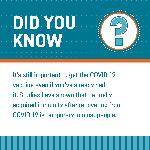 COVID-19 vaccine after infection Image
COVID-19 vaccine after infection Image
It’s still important to get the COVID-19 vaccine even if you’ve already had it. Studies have shown that naturally acquired immunity after recovering from COVID-19 is temporary in most people. -
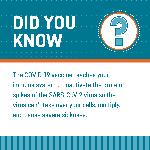 COVID-19 vaccine lesson Image
COVID-19 vaccine lesson Image
The COVID-19 vaccine teaches your immune system to inactivate the protein spikes of the SARS-CoV-2 virus so the virus can’t take over your cells, multiply, and cause severe sickness. -
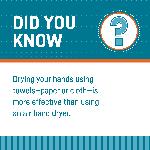 Drying one's hands Image
Drying one's hands Image
Drying your hands using towels - paper or cloth - is more effective than using an air hand dryer. -
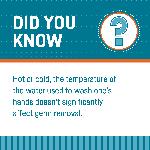 Hand washing water temperature Image
Hand washing water temperature Image
Hot and cold, the temperature of the water used to wash one’s hands doesn’t significantly affect germ removal. -
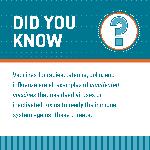 Inactivated vaccines Image
Inactivated vaccines Image
Vaccines for rabies, tetanus, polio, and influenza are all examples of inactivated toxins to ready the immune system against these threats. -
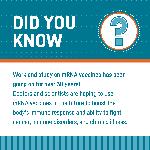 Long-term mRNA studies Image
Long-term mRNA studies Image
Work and study on mRNA vaccines has been going on for over 30 years! Doctors and scientists are hoping to use mRNA vaccines in the future to boost the body’s immune response and ability to fight cancer, immune disorders, and chronic illness. -
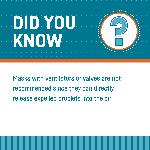 Masks with vents/valves Image
Masks with vents/valves Image
Masks with ventilators or valves are not recommended since they can directly release expelled droplets into the air. -
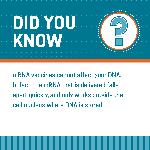 mRNA and your DNA Image
mRNA and your DNA Image
mRNA vaccines cannot affect your DNA. In fact, the mRNA that is delivered falls apart quickly, and only works outside the cell nucleus where DNA is stored. -
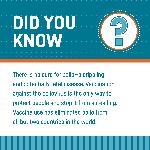 Polio vaccination response Image
Polio vaccination response Image
There is no cure for polio - a crippling and potentially fatal disease. Vaccination against the poliovirus is the only way to protect people and stop it from spreading. Vaccine use has eliminated polio from all but two countries in the world. -
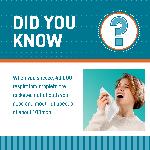 Power of a sneeze Image
Power of a sneeze Image
When you sneeze, 40,000 respiratory droplets are rocketed out of both your nose and mouth at speeds of about 100mph! -
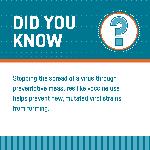 Prevention through vaccines Image
Prevention through vaccines Image
Stopping the spread of a virus through preventative measures like vaccine use helps prevent new, mutated, viral strains from forming. -
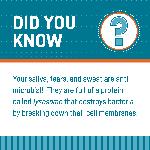 Protection with lysosome Image
Protection with lysosome Image
Your saliva, tears, and sweat are anti-microbial! They are full of protein called lysosome that destroys bacteria by breaking down their cell membranes. -
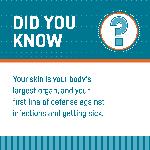 Skin - your first defense Image
Skin - your first defense Image
Your skin is your body’s largest organ, and your first line of defense against infections and getting sick. -
 Synthetic fabrics Image
Synthetic fabrics Image
Synthetic fabrics are not as good as catching small particles as cotton is when used as a face mask. -
 Tetanus Image
Tetanus Image
Tetanus, a painful debilitating condition caused by a bacterial toxin, is more common in countries where the tetanus vaccine is not in widespread use. -
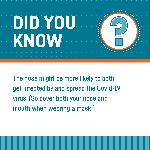 The nose - contract and spread viruses Image
The nose - contract and spread viruses Image
The nose might be more likely to both get infected by and spread the COVID-19 virus. (So cover both your nose and mouth when wearing a mask!) -
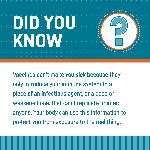 Vaccine can't make you sick Image
Vaccine can't make you sick Image
Vaccines can’t make you sick because they only introduce your immune system to a piece of an infectious agent, or a dead or weakened one, that can’t replicate or infect anyone. -
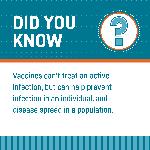 Vaccine prevent, not treat infections Image
Vaccine prevent, not treat infections Image
Vaccines can’t treat an active infection, but can help prevent infection in an individual, and disease spread in a population.